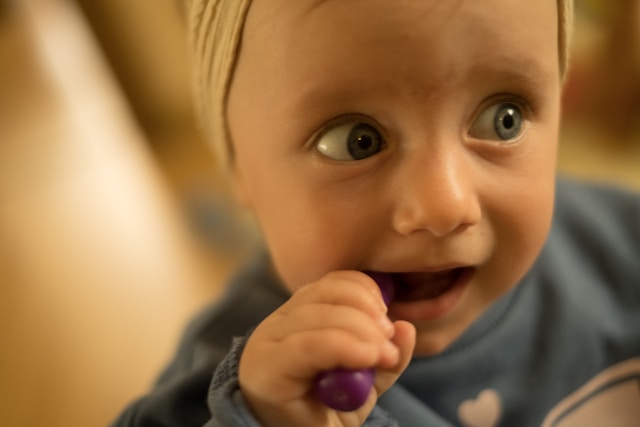It all started one sunny afternoon. Meera was playing with her 7-month-old daughter, Ehaani, in the living room. Suddenly, Meera noticed something amusing yet slightly nerve-wracking—Ehaani had picked up a toy block and, in an instant, it was in her mouth! Over the next few days, Meera observed Ehaani putting anything within reach into her mouth—whether it was a toy, her blanket, or even her dad Rahul’s fingers! Concerned yet curious, Meera couldn’t help but wonder why her little one was exploring the world this way.
If you’re like Meera, you’ve probably wondered, “Why does my baby put everything in her mouth?” This phase, known as oral exploration, is a normal and crucial stage in a baby’s development. In this blog, we’ll explore why babies are naturally inclined to mouth objects, what this behavior signifies, and how you can support safe, healthy exploration.
Understanding Oral Exploration in Babies
Babies are born with a strong instinct to explore the world around them, and one of the primary ways they do this is through their mouth. Oral exploration typically begins as early as three to four months and can extend up to two years of age. This behavior serves multiple developmental purposes:
Sensory Development: Babies are drawn to put objects in their mouths because the mouth has more nerve endings than most other parts of the body. Through mouthing, they experience different textures, shapes, and even temperatures, which contribute to sensory development.
Building Awareness: Mouthing helps babies build awareness of their surroundings. By feeling objects with their mouth, they get a better understanding of object sizes, softness, and textures, all of which aid in developing motor skills.
Soothing Teething Pain: Between 4-6 months, most babies begin teething. Mouthing objects provides natural relief by applying gentle pressure on the gums, which can be soothing during this uncomfortable phase.
Curiosity and Learning: Babies learn about the world through curiosity. Each item they mouth brings new information, enhancing their cognitive development and curiosity about the world around them.
Developing Hand-Eye Coordination: Reaching out, picking up an object, and putting it in their mouth requires significant coordination. This process is an early step in developing fine motor skills, which will eventually aid in tasks like feeding and writing.
Why Parents Shouldn’t Panic: Mouthing as a Healthy Sign
While the constant need to put things in their mouths can feel worrisome, it’s a sign that your baby is developing normally. It shows that your child is curious, learning, and building essential skills through self-directed exploration. However, parents should always keep an eye on the safety of what’s being explored.
Creating a Safe Mouthing Environment

The best way to support your baby during this phase is by creating a safe environment that allows for healthy exploration. Here are some tips to keep in mind:
Choose Non-Toxic, Safe Toys: Provide toys that are safe for mouthing, preferably labeled as BPA-free, non-toxic, and free of sharp edges or small parts. Silicone teething rings, cloth toys, and wooden rings are excellent choices for young children.
Clean Toys and Objects Regularly: Babies’ immune systems are still developing, so it’s important to regularly sanitize toys and objects your baby plays with. Warm soapy water or non-toxic wipes designed for baby items can be used to keep toys clean and safe.
Inspect Items Carefully: Avoid small objects, detachable parts, or anything that could pose a choking hazard. Items smaller than a golf ball should be kept out of reach, as they can easily slip into a baby’s mouth and become lodged in their throat.
Monitor Outdoor Play: While it’s great to let babies experience outdoor play, keep an eye on them to prevent them from mouthing dirty items like sticks, rocks, or leaves that could carry harmful bacteria.
Offer Safe, Baby-Friendly Food Textures: Soft foods like mashed bananas, steamed vegetables, and purees offer different textures and flavors, allowing babies to safely experience a variety of tastes without the risk of choking.
Common Concerns About Mouthing and What to Do
1. Germs and Infections
Solution: Babies are likely to encounter germs during this phase, but mild exposure to germs can help build immunity. Ensure toys are cleaned regularly and focus on keeping commonly mouthed items, like teething rings, sanitized.
2. Choking Hazards
Solution: Keep small, detachable items out of reach. It’s helpful to follow the rule: if it’s smaller than a golf ball, it’s unsafe for mouthing.
3. Chemical Concerns
Solution: Use non-toxic toys made of silicone, wood, or fabric. Avoid plastic toys with BPA and phthalates. Read product labels to ensure they meet child safety standards.
Read More:
Is Finger-Sucking Safe for Infants? A Comprehensive Guide
Finger Sucking in Children: Understanding the Habit and Its Implications
Homemade Baby Food Recipes for 1 year-old
The Best Advice For Young Moms To Have A Meaningful Motherhood
FAQs
1. When do babies start and stop putting things in their mouth?
Babies typically begin mouthing objects around 3-4 months and may continue until they’re around 2 years old. By this age, they often find other ways to explore their environment, and the habit naturally fades.
2. Is it safe for my baby to put everything in her mouth?
Mouthing is a natural developmental phase, but it’s essential to ensure the objects are clean, non-toxic, and not small enough to choke on. With precautions, mouthing can be a safe and beneficial activity.
3. How can I discourage my baby from putting dirty items in her mouth?
Gently redirect your baby to a safe, clean object each time they try to mouth an inappropriate item. Over time, they’ll learn what is and isn’t suitable for mouthing.
4. What should I do if my baby puts something potentially harmful in her mouth?
Stay calm and remove the item as gently as possible. If they’ve swallowed a harmful object, seek medical help immediately. If the object was simply unsanitary, monitor your baby and contact a pediatrician if any unusual symptoms occur.
5. Does mouthing help with speech development?
Yes, mouthing can support early speech development by strengthening mouth and tongue muscles. It also helps babies understand sensations associated with different textures, which contributes to oral-motor skills.
6. Can teething toys help my baby stop mouthing other objects?
Yes, providing teething toys can satisfy the urge to mouth objects, especially if your baby is teething. Teething rings and cold washcloths can offer safe relief and reduce the desire to mouth other items.
7. Is it normal for my baby to mouth things when they’re older?
Some toddlers continue mouthing into their second year. This can be normal, but if mouthing persists beyond age three, consulting a pediatrician or occupational therapist may be helpful.
8. How can I tell if my baby’s mouthing behavior is normal or excessive?
Normal mouthing is exploratory and occasional. If your baby is excessively mouthing to the point of rejecting other activities or exhibiting repetitive behavior, discuss it with your pediatrician to rule out developmental concerns.
Read More:
Why Vitamin D3 is Essential for Children Up to One Year: Benefits, Dosages, and Best Brands
10 Types of New Born Baby Clothes Every Parent Must Know
Best Oils for Baby Massage | Oils to Avoid for Baby Massage
Supporting Your Baby’s Healthy Exploration
Encouraging safe mouthing can be a joyful experience for both baby and parent. Like Meera, who now sees this phase with fascination rather than worry, you can support your baby’s growth and learning. Providing a safe environment, keeping their toys clean, and offering plenty of sensory-friendly items can make this natural phase a fun and enriching one. Remember, your baby’s exploration is an exciting way they’re learning about their world!
As you journey through this phase together, celebrate each new discovery—your little one is growing, learning, and becoming familiar with the world, one taste, texture, and touch at a time.

